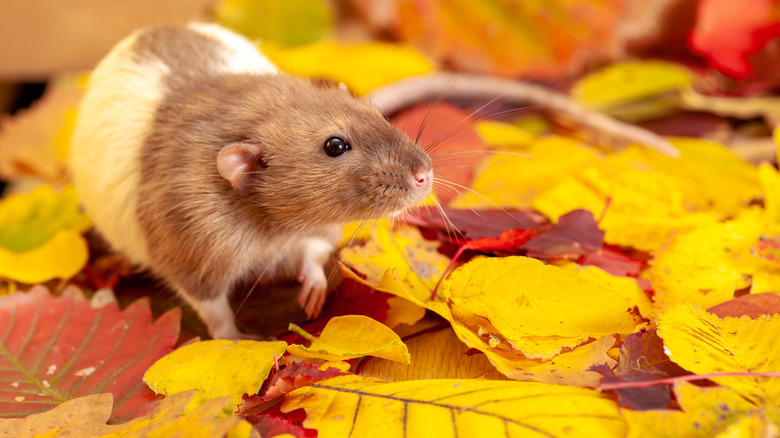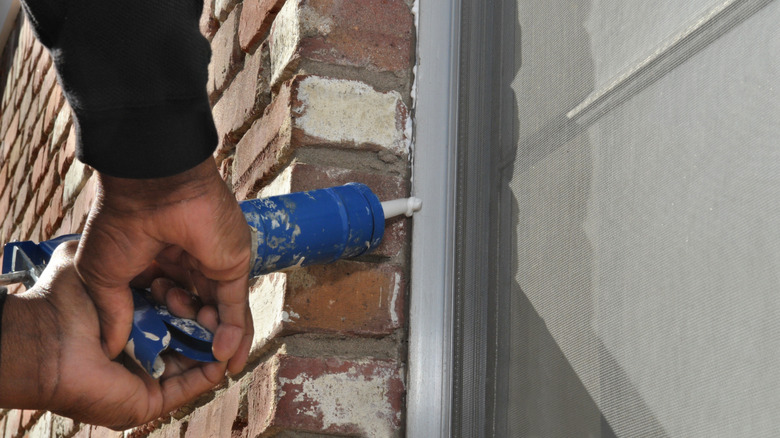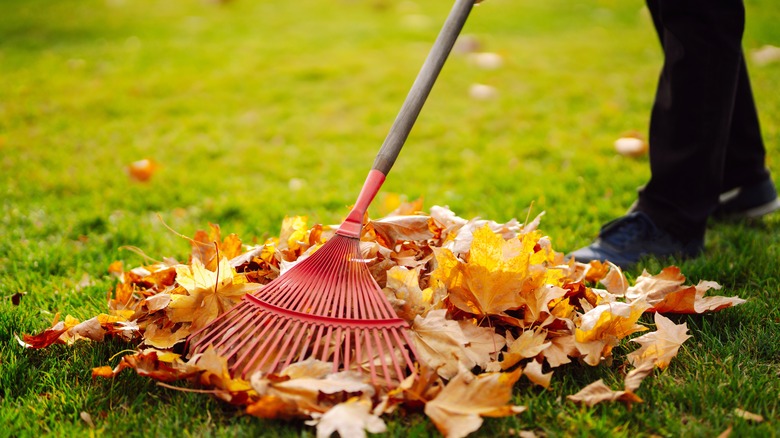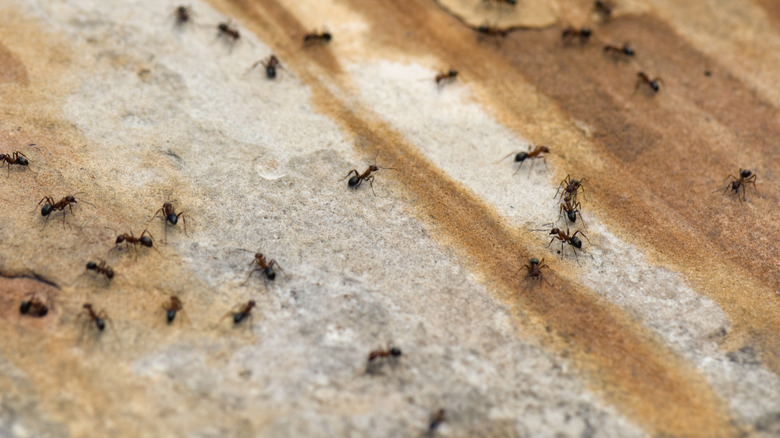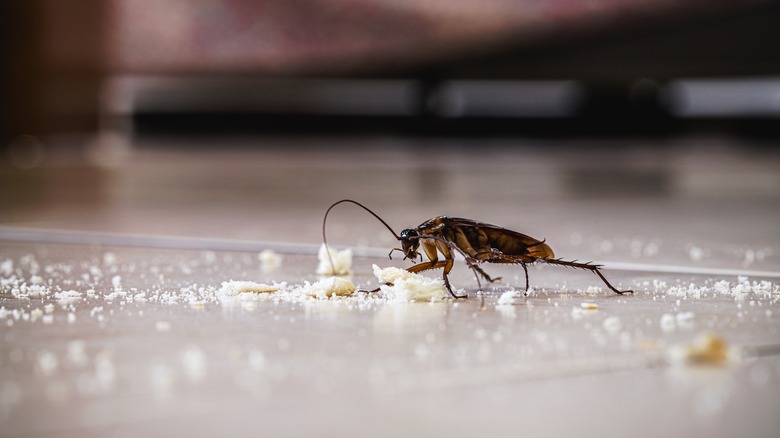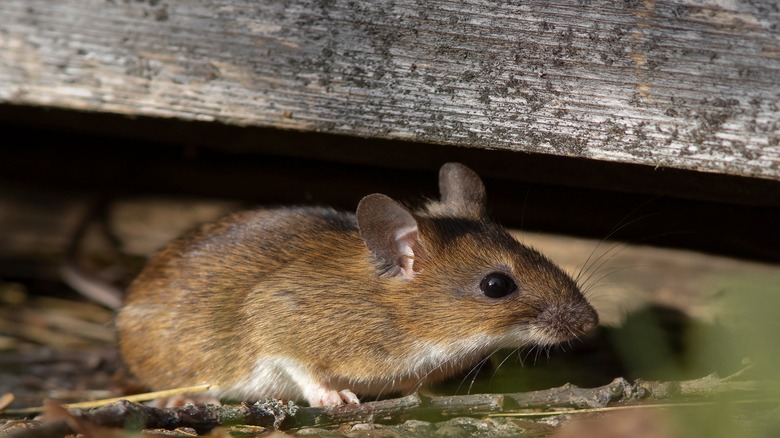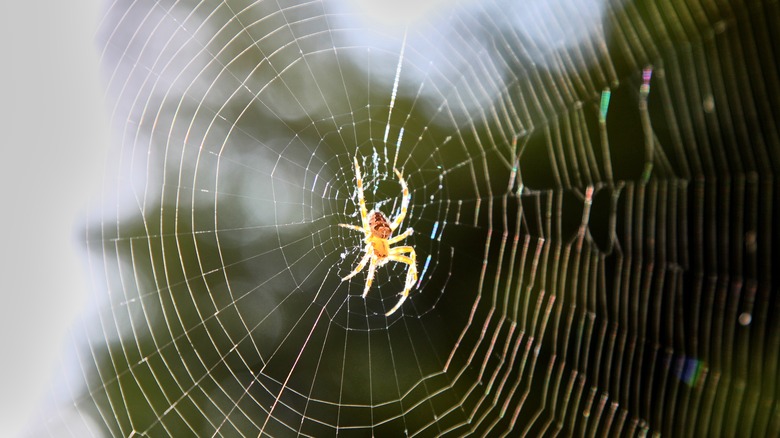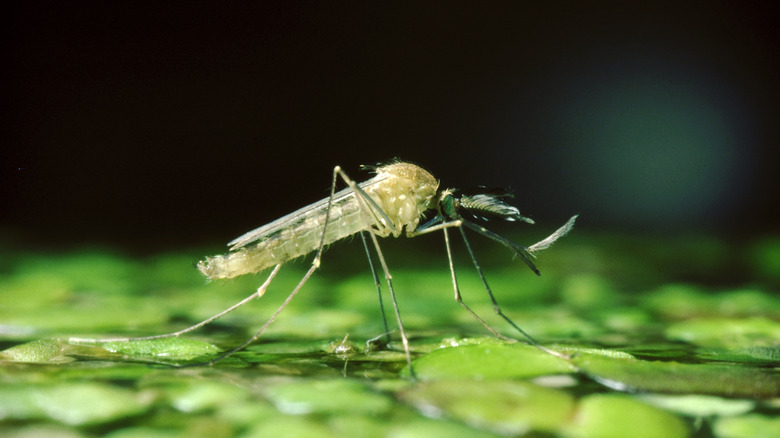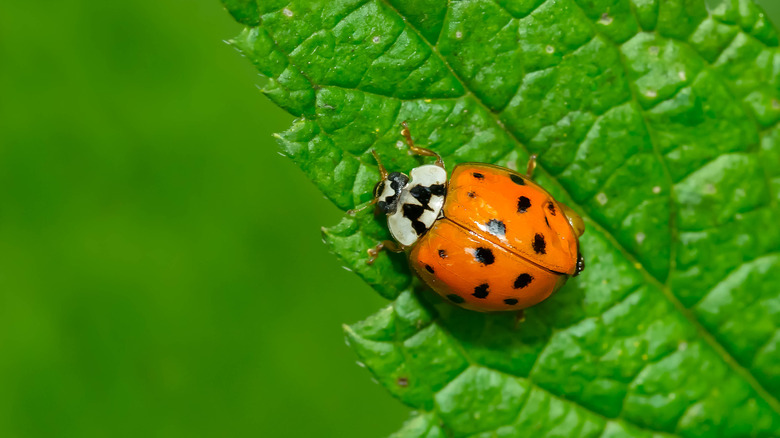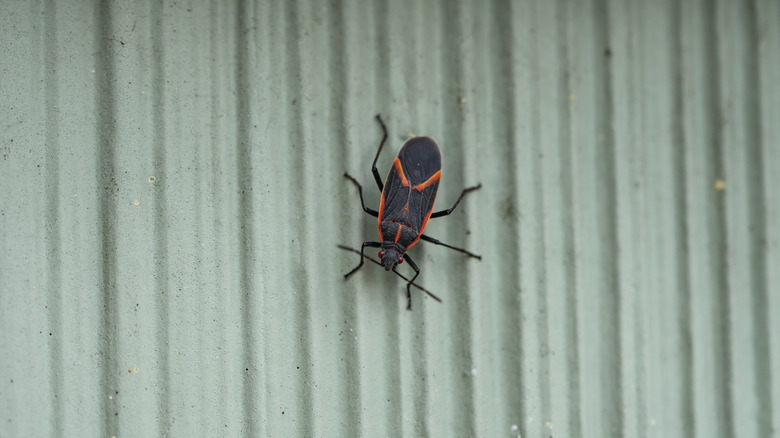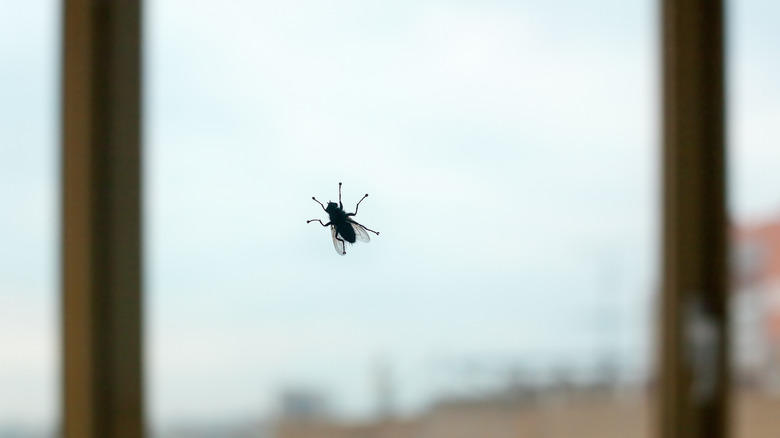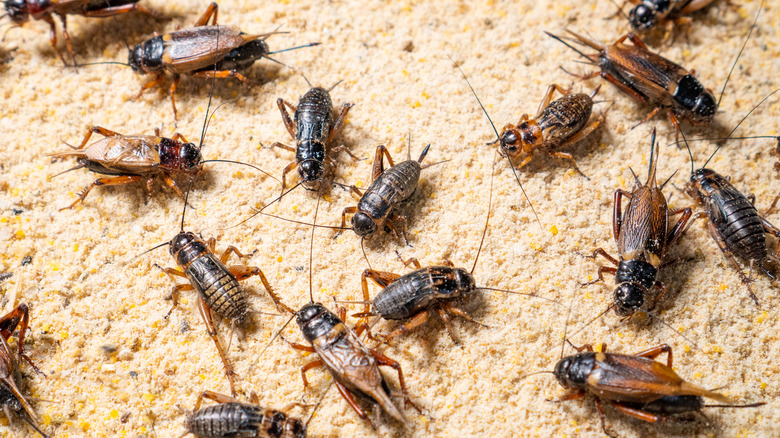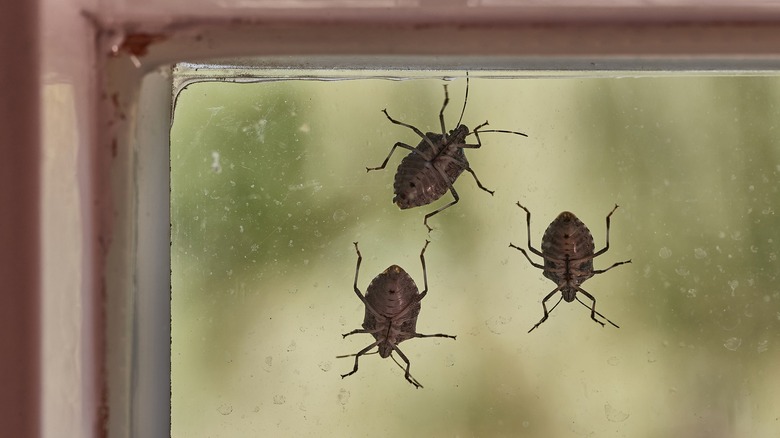The Best Ways To Take Care Of Pesky Autumn Pests
Autumn marks the start of cooler weather, shorter days, and stunning fall foliage. It also marks a time of year when certain creepy crawlies come out of the woodwork. Some wildlife likes to wander indoors to find somewhere cozy to live for the winter — but that doesn't mean you want to share your space! When it comes to pests, preventative steps are well worth the effort. But if a common pest gets into your home, it's often a problem you can tackle yourself, especially with a few of these tips fresh in your mind.
Of course, the removal or extermination strategy depends on the animal. We break down ways to take care of common autumn pests, from spooky spiders to furry mice. We've included natural, kid-, and pet-friendly options, as well as more heavy-duty methods for getting rid of critters. Just keep in mind: If you have an infestation, DIY methods may not always work, in which case it's time to call in professional exterminators.
General preventative steps for fall pests
The best way to manage fall pests in your home is to stop them from getting inside in the first place. This means filling any gaps and cracks in the exterior of your home. Of course, obvious gaps in a home's foundation, roof, or siding can wave bugs and rodents inside, but you should seal the less obvious spots, too. For example, bugs can get into spaces as small as the gap around where cables or pipes enter the building. Use caulk, concrete patch products, expanding foam insulation, or other suitable sealants to seal possible entry points.
After a few summers of use, your window screens might look worse for wear. Replace or repair any broken screens. Protect your entryways, too. You can install door sweeps on all exterior doors and check your weatherstripping and garage door seals. Lastly, leaks and moisture can attract a range of animals, so make sure to have the cause tracked down, and any water-damaged areas repaired.
Pay special attention to certain areas
Pests love messy spaces with plenty of spots for them to hide. Because of that, clean up the garden, garage, basement, and other storage spaces like the attic. The fewer hidey-holes the better, so clear away excess clutter, indoors and outdoors. While doing so, check for signs of pests, like droppings and dead bugs. Sometimes they can sneak in unnoticed, especially in less-visited areas like the attic! To provide less temptation to animal intruders, it doesn't hurt to go through the kitchen as well and seal open and loose food into air-tight containers.
Once again, pest proofing really begins at the exterior of your home. Don't let outdoor debris sit. Clear your yard as much as possible of the things that bugs love, like fallen leaves and moist mulch. Ideally, vegetation shouldn't touch the home. Branches and leaves can provide pests with direct access to a building. Terminix recommends keeping at least six feet of clearance between vegetation and the house exterior. It's also a good idea to keep firewood well away from the home since a wood pile is a popular hiding spot for many pests.
Ants
It's never fun coming upon a swarm of ants in your home, and it's especially unsettling if they're large or have wings. Ants often wander inside searching for food, so keep tasty treats inaccessible and the kitchen clean. Crumbs, spills, an overflowing garbage bin, and dirty dishes are lures for these bugs. One or two ants wandering indoors isn't usually a problem. You can simply use a vinegar and water solution to wipe ant trails, which will throw them off the scent. But if you're seeing larger populations, you'll want to deal with it before it becomes a bigger issue.
The first step is to identify the type of ant. Most ants won't cause harm and are simply a nuisance. However, carpenter ants can cause damage to wooden structures, so if you suspect an infestation of this type, it's worth calling the professionals. You can deal with most other types on your own. Ant baits are one of the most effective ways to deal with an indoor nest. Worker ants take the poisonous bait back to the colony, which will kill the queen and other ants when they eat it. Commercially available baits are usually only effective against the most common household ant types. If they don't work for the ants in your home, it's worth calling a professional exterminator.
Cockroaches
Come fall, cockroaches like to come indoors for the warmer conditions. Cockroaches look icky enough, but they can also reproduce quickly, carry bacteria and germs, and trigger allergies and asthma, so you'll want to promptly take care of a possible infestation. Similar to ants, taking away food sources is the first step. Ensure food is never left out and thoroughly clean up crumbs and spills. Clean floors regularly and remove possible water sources, like drippy faucets. Since roaches love moisture, you'll also want to air out any moisture-prone areas (like under the kitchen sink), put away pet water dishes overnight, and even dry sinks, tubs, and showers after use.
Sticky traps and a good vacuum may be enough to get rid of some roaches. If you're having a hard time spotting them, you can use a hairdryer to get roaches out of their hiding spots, then follow up by vacuuming them up. If physical methods don't work, pesticides are the next step. First, identify the cockroach type. Then you can try baited traps or gel baits to target the pests. Try a few different types for the best results. If all else fails, it's worth a call to a professional exterminator to eliminate these nasty pests.
Rodents and other mammals
Mice, rats, squirrels, raccoons, and other mammals may try to seek warmth in your home during the colder months. Since they are disease carriers and can cause property damage, they're an unwelcome houseguest. Due to their larger size, preventing entry is one of the best ways to prevent these furry critters from taking up shelter in your home. Mice can squeeze into some very small holes — seal any openings bigger than a 1/4-inch to prevent entry. It also helps to make your home less tempting by keeping it clean, eliminating food sources like crumbs and open food containers.
If mice and rats get into your home, the best way to deal with them is with snap traps, which are effective and kill quickly. Glue traps can also be used, but with caution; they won't actually kill the mouse or rat, so they can be a bit cruel and leave you to deal with the live animal. It's not recommended to use rodent poison. Since they don't kill right away, the rodents have the chance to run away and hide elsewhere in the home, which can be a very unpleasant and odorous surprise when they decay.
Squirrels and raccoons love a warm and easy-to-access attic. Luckily, if you've sealed holes and gaps larger than ¼-inch to prevent mice, these larger animals also can't get in. If one does find its way into your attic, it's best to hire a professional to relocate them safely outdoors.
Spiders
Spooky spiders are a Halloween decor mainstay, but that doesn't mean you want real eight-legged guests in your house. Pesticides generally aren't very effective against spiders, so prevention is an easier alternative. Like with other pests, keeping your home neat can help dissuade spiders from moving in. Less clutter overall and a tidy kitchen means less hiding spots and fewer bugs (spider's food source). Spiders also don't like the smell of peppermint oil, so you can create a repelling spray by mixing around 20 drops of peppermint oil into a spray bottle of water and spraying in corners, entrances, and along floorboards.
When you spot a spider in the home, you can kill it by whacking it or sucking it up in a vacuum. For less squeamish, you can relocate the bug outside instead. Sticky traps can help catch those roaming around the home when you're not around.
Mosquitoes
A warm fall can mean mosquitoes hanging around well past summer, and in some areas, mosquitoes can be a year-round pest. They're more than just an annoying bug, and can be a disease transmitter. The same tips used to control mosquitoes in the summer also apply to the fall. It starts with your outdoor space: remove standing water. This can mean the water that accumulates in plant pots, toys, pool covers, recycling bins, and any other possible containers. For spots that need water, like bird baths and pet bowls, empty and clean these vessels once a week. Also, clean areas where water can back up, such as in gutters, and fix any sources of water like leaking hoses and faucets.
Mosquitoes don't really search for cracks to get in the house like other bugs. To keep them out, use bug screens on your windows and doors and turn outside lights off at night. To protect yourself from getting bitten, you can use insect repellent and bug-repellent clothing, especially if sitting outdoors at dawn and dusk, which is their most active time. If a mosquito makes its way indoors, there's not much else you can do but take a whack and kill it.
Multicolored Asian lady beetle
Ladybugs have a good reputation, but in fall, they can congregate indoors, which is less than pleasant. Multicolored Asian lady beetles are a type of ladybug, and like others of this species, they can be beneficial in the garden, but not so much inside the home. While these bugs won't cause damage, they can bite and secrete a smelly fluid that can stain light surfaces if spooked.
Pest proofing can prevent these beetles from coming inside. Some preventative insecticide sprays work against ladybugs as well in infestation-prone areas. These can be sprayed on the home exterior in early fall. If some make it inside the home, don't fret — just relocate the ladybug outside. Since multicolored Asian lady beetles can secrete a staining and smelly liquid when squished, you're better off just moving them out of your home. You can either use a broom and dustpan to place them outside, or use a vacuum and then empty the vacuum bin or seal and toss the vacuum bag. (Vacuuming alone won't always kill ladybugs).
Boxelder bugs
Boxelder bugs aren't destructive or disease-spreading, but if you don't like bugs, they're still a nuisance to see in your home. In the fall, they try to make their way inside homes through cracks and gaps to find a spot to overwinter. Luckily, they won't damage your home, munch on your food, or create a nest or breed inside. Come spring, they'll just want to make their way outdoors again. However, their droppings can stain light-colored fabrics, and they can cause stains (and emit a bad odor) if you squish them, so you'll want to remove them rather than crush them. You can relocate them back outdoors with a broom and dustpan. Another option is to suck them up in a vacuum cleaner, though you will need to empty the vacuum bin outdoors or isolate the vacuum bag to prevent the bug from re-escaping into your home.
Boxelder bugs can congregate in large numbers, particularly on warm, sunny surfaces of building exteriors. When they gather on homes in the fall, they might be looking for a way in, so you can opt for an insecticide to deal with large groups. Call an exterminator to apply a suitable product for prevention or extermination. For spot-treating a crowd, you can make a safe boxelder bug killer at home. The North Dakota State University Extension recommends mixing three to five tablespoons of liquid detergent with a gallon of water and using the solution to spray and kill bothersome bugs. You'll need to do this several times for it to be effective.
Cluster flies
We often think of flies as a summer pest, but it turns out they can also plague your home into the colder seasons. When the mercury drops, cluster flies look for a cozy place to overwinter, trying to make their way into your nicely heated homes. While they won't damage your home structure or reproduce inside, a warm fall or winter day can result in an influx of these unwelcome critters appearing out of wall voids and other hiding spots. Like other pests, the first and most effective preventative is reducing entry opportunities. Fixing and sealing window and door screens is especially important when dissuading flies. If large numbers of cluster flies gather outside your home come fall, you can call a pest control company to treat exterior surfaces.
Once flies are indoors, there's not much benefit in using insecticides. Instead, a fly swatter, rolled-up newspaper, or other swatting method will be your weapon of choice. If you have a large number indoors, you'll want to locate how they came in to prevent the same problem next year.
Crickets
There's something nostalgic about hearing crickets chirping — unless you realize the sound is coming from inside your home. Luckily, crickets are another nuisance pest, which means they won't cause serious damage to your house itself. However, some types can feed on paper and fabrics, so it's still worth dealing with a cricket problem.
These are another pest that make their way inside through gaps in doors and windows or cracks in a home's exterior. They're attracted to light, so switching off outdoor lights at night can also make your home less appealing. A clean and dry home is less tempting to crickets, so it doesn't hurt to keep your space neat. If a cricket or two makes it indoors, snagging them with a vacuum or leaving out some glue traps should get rid of the problem quickly. However, in some areas, crowds of crickets are just a fact of life. Some outdoor pesticides can control large numbers of crickets around the home, but try non-chemical methods first.
Stink bugs
Stink bugs are another harmless nuisance. They won't sting, bite, reproduce indoors, or do any damage to your home, but they do live up to their name. Stink bugs can emit a strong odor when threatened or squished. To avoid these bugs and their stench, stop them from getting indoors in the first place by physically bug-proofing your home. Insecticides aren't generally recommended, but can be applied in fall by a licensed professional if sealing the house is not possible. Insecticides are not effective for treating stink bugs that have already made their way indoors.
Don't squish a stink bug; you won't enjoy the smell. They can also leave a temporary smell in your vacuum, so proceed cautiously. If you can, use a shop vacuum or other less frequently used machine to suck up these bugs. Empty the vacuum outdoors shortly after to make sure no surviving stink bugs escape back into the home and to reduce exposure to the smell. Another alternative is to use a dustpan or even pick it up by hand or with a tissue (they don't bite!) to relocate the bug outdoors. Or, if you want to ensure the bug isn't a potential future problem, you can flush it down the toilet or drop it into a container of soapy water, which will kill the stink bug.
